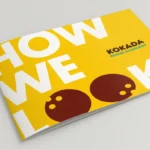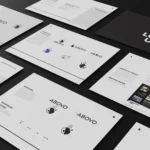In the world of (effective) branding, consistency is crucial. Just as a master carpenter relies on precision and consistency to craft pieces that stand the test of time, a well-crafted brand style guide serves as the blueprint for your brand’s identity for whoever is working with it. Think of it as your brand’s bible, a comprehensive document that outlines how your brand presents itself to the world. It ensures every touchpoint with your audience resonates with the same core message and aesthetic, from your website to your social media, and beyond. Team Abovo understands the power of a cohesive brand identity because we work with them everyday, and we’re here to share our insights on crafting a basic yet comprehensive brand style guide that lays the foundation for your brand’s visual and communicative expression. If you’re starting from scratch or starting the process of updating a brand style guide, below are the items and sections we think should be considered as essential. We’ll briefly define each one and, to help guide your process, we’ll use the company Apple to provide examples.
Organization Mission Statement
Your mission statement is the heart of your brand. It articulates your purpose and what you stand for. It’s more than a sentence; it’s your brand’s reason for being. Whether you have a brand style guide or not, you should have this written down (I.E. this one should be easy as it should already be done!).
Apple Example: To bring the best user experience to its customers through its innovative hardware, software and services.
Brand Mission Statement
While closely aligned with your organization’s mission, the brand mission zeroes in on what your brand seeks to achieve in the marketplace. It’s your promise to your customers.
Apple Example: To empower creative exploration and self-expression through user-friendly and cutting-edge technology.
Organization Vision Statement
The vision statement is your brand’s north star. It outlines where you see your brand in the future, guiding your path and inspiring your team and customers alike.
Apple Example: We envision a world where technology and humanity intersect seamlessly, enhancing daily life and expanding the boundaries of what’s possible.
Organization Primary Value
This is your unique value proposition. What makes you stand out? For instance, at Abovo, it’s “Creative marketing for brands we believe in.” It’s that special something that makes your brand, your brand.
Apple Example: Apple’s primary value could be stated as “Innovation through simplicity.” This reflects Apple’s commitment to creating products that are both cutting-edge and easy to use.
Core Values
These are the principles that define your brand’s culture and ethics. Core values guide decision-making and behavior, both internally and in how your brand interacts with the world.
Apple Example: Integrity, innovation, quality, collaboration, and customer focus. Apple’s core values emphasize the importance of ethical business practices, continuous innovation, high-quality standards, teamwork, and putting the customer at the center of everything they do.
Brand Voice and Tone
Your brand’s voice is its personality, while the tone may change depending on the context. Defining how your brand always sounds (maybe authoritative, friendly), never sounds (likely condescending, aloof), and sometimes sounds (perhaps humorous, serious) ensures consistent communication.
Apple Example: Apple always sounds innovative, friendly, and direct. It never sounds complicated or inaccessible. Sometimes, especially in product launch events, Apple sounds inspirational and visionary, aiming to excite and engage its audience.
Brand Words
Identify words that embody your brand, as well as words that don’t. This helps maintain a consistent brand narrative across all forms of communication.
Apple Example: Words to use: Innovative, intuitive, design, revolution, seamless. Words not to use: Complicated, difficult, inferior, outdated.
Brand Visibility
This section outlines where and how your brand will be seen. From social media to billboards, knowing where your brand lives helps in crafting tailored content.
Apple Example: Apple’s brand is visible in its retail stores, product packaging, advertisements, and keynote presentations (amongst many other places, but limiting this list for brevity).
Primary Logomark and Usage Rules
Your logomark is your brand’s visual signature. Detailing its proper use ensures it’s displayed consistently across various platforms which may include a variety of rules including size, margins, spacing and more. Your organization should only have one primary logomark.
Apple Example: The iconic Apple logo is a symbol of innovation and simplicity. Usage rules dictate maintaining its proportions, ensuring it’s not overcrowded by other elements, and using it consistently across all platforms and products.
Brand Architecture
This involves listing sub-brands, affiliated brands, organizational departments and more to aid in establishing clear relationships and hierarchies. This is especially important in the case subsidiary brands have different rules and guidelines.
Apple Example: Apple Inc. oversees a range of products and services, including iPhone, iPad, Mac, Apple Watch, Apple TV, iOS, macOS, watchOS, and services like Apple Music, Apple Pay, and the App Store. Each product and service aligns with Apple’s overarching brand identity while also having its unique sub-brand identity.
Primary Color Palette
Colors evoke emotions and communicate your brand’s essence at a glance. Your primary palette is your brand’s most dominant colors. Your brand’s primary color(s) should typically only be the ones found/used in your primary logomark (item #9).
Apple Example: Apple’s primary color palette is minimalist, featuring a lot of white space, with black and silver tones that convey simplicity, sophistication, and elegance.
Secondary Color Palette
Secondary colors complement your primary palette, offering versatility while maintaining brand identity.
Apple Example: The secondary palette includes shades of gray, along with product-specific colors like the vibrant hues of the iPhone line, which are used sparingly to accentuate and differentiate products.
Logo Variations
Different contexts require different logo formats. This section outlines approved variations and their specific usage guidelines. Common variations for a brand include a stacked logo, type (text) only, icon only and badges.
Apple Example: Apple uses different logo variations, such as the monochrome Apple logo for most of its products and the rainbow-colored Apple logo for its Pride Edition products. Each variation has specific guidelines for its use.
Logo Variations
Different contexts require different logo formats. This section outlines approved variations and their specific usage guidelines. Common variations for a brand include a stacked logo, type (text) only, icon only and badges.
Apple Example: Apple uses different logo variations, such as the monochrome Apple logo for most of its products and the rainbow-colored Apple logo for its Pride Edition products. Each variation has specific guidelines for its use.
Primary Font
Your primary font is used in most of your brand communications, embodying your brand’s voice in text form. This should not be the font used in your logo.
Apple Example: San Francisco is Apple’s primary typeface, used across its software interfaces, marketing, and packaging, reflecting clarity and simplicity.
Logo Font
The font used in your logo may be exclusive to it to maintain its uniqueness. This section documents it but restricts its use elsewhere.
Apple Example: The Apple logo itself does not incorporate a wordmark in its most recognized form. However, when “Apple” is written alongside the logo, the company uses a clean, sans-serif font that complements its minimalist aesthetic.
Secondary Font(s)
Having alternative fonts ensures flexibility while keeping your communications cohesive. Include a go-to font when primary choices aren’t available.
Apple Example: New York is a secondary serif typeface that Apple uses for longer texts to complement the San Francisco font, providing readability and elegance in detailed content.
Secondary Font(s)
Having alternative fonts ensures flexibility while keeping your communications cohesive. Include a go-to font when primary choices aren’t available.
Apple Example: New York is a secondary serif typeface that Apple uses for longer texts to complement the San Francisco font, providing readability and elegance in detailed content.
Web Fonts
Web-friendly fonts ensure your online presence is as polished and consistent as your offline materials.
Apple Example: Apple uses a range of web-optimized fonts, including versions of San Francisco, to ensure text is crisp and clear on all digital platforms, maintaining brand consistency online.
Textures/Patterns
Textures and patterns can add depth and dimension to your brand identity, used sparingly to accent and enhance.
Apple Example: Apple rarely uses textures or patterns in its branding, favoring a clean, minimalist design. When used, subtle gradients or light textures might be applied to backgrounds in software interfaces or promotional materials to add depth without overwhelming the design.
In wrapping up, it’s important to recognize that the 19 items detailed above represent just the essentials, as defined by Team Abovo, for laying the groundwork of a strong, cohesive brand identity. However, to fully capture the depth and breadth of your brand’s essence, there are many more elements you might consider for a more comprehensive set of brand guidelines (but that’s a whole different blog and conversation).
Creating a brand style guide that is made up of all of the 19 items above will result in a well-defined brand style guide, that we promise will become an indispensable tool for your organization and establish a strong, cohesive brand identity. It serves as the foundation upon which all your marketing efforts are built, ensuring consistency across every touchpoint with your audience. From your mission statement to your color palette, every element of your brand style guide plays a crucial role in telling your brand’s story.
Crafting a comprehensive brand style guide may seem daunting at first, but by breaking down the process into manageable steps, you can create a document that truly encapsulates the essence of your brand. Start with the core elements—your mission, vision, and values—to establish a solid foundation. These components will guide the tone, voice and aesthetic choices you make thereafter.
Engage your team in the process, gathering input from various departments to ensure the guide is inclusive and reflective of your brand’s collective vision. Regularly review and update your style guide to keep it relevant as your brand evolves. Remember, your brand style guide is a living document that grows with your organization.
Lastly, consider the implementation phase as critical as the creation of the guide itself. Educate your team, partners, and vendors on the guidelines to ensure widespread adoption. The more consistently your brand is represented, the stronger it becomes in the minds of your customers.
A brand style guide is not just a set of rules; it’s a roadmap to building a brand that resonates deeply with your audience and stands out in a crowded marketplace. Start with clarity and purpose, and let your brand’s unique story unfold.






